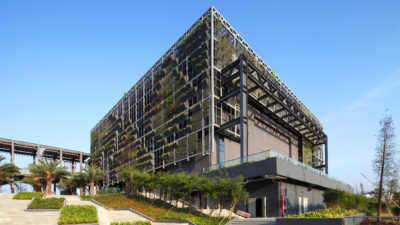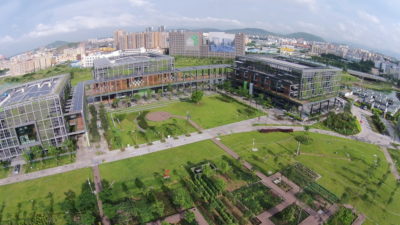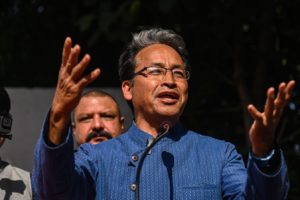The northeastern fringes of Shenzhen — a fishing village that has been rapidly transformed into a global port city of at least 11 million people — are a patchwork of drab factories spewing smoke, and multi-lane highways packed with container trucks. The area epitomizes the severe pollution and runaway urbanization that have dogged southern Guangdong province since China’s ruling Communist Party began to embrace capitalism in the 1980s.
Yet one side road here leads to a jarringly different scene: A riverside plot landscaped with bamboo trees and elevated boardwalks and dotted with energy-efficient buildings that a state-run developer either built from scratch or refashioned from the shells of old factories. “It’s a demonstration of how we can live in a place without pollution and with clear air,” Cheng Fang, a spokeswoman for the developer, said on a recent afternoon at the eco-complex.
Over the last decade, China has taken ambitious steps to begin curbing its carbon footprint. In 2009 the powerful State Council announced a plan to reduce the carbon intensity of the national gross domestic product by 40 to 45 percent by 2020 compared with 2005 levels. And in 2014, President Xi Jinping pledged to peak China’s emissions around 2030 and increase the share of renewable energy sources in the economy from 8.3 percent in 2010 to roughly 20 percent by 2030. Both moves helped lay the groundwork for last year’s landmark climate agreement in Paris, which China and the United States formally ratified this month at the G20 gathering of heads of state in the Chinese city of Hangzhou.
A low-carbon pilot program now underway in 13 Chinese provinces and cities, including Shenzhen, is yet another sign of China’s carbon-cutting ambitions.
Under the program, which the National Development and Reform Commission launched in 2010, the municipalities have drafted policies that prioritize increasing the share of biogas and solar energy in the local energy supply, tightening fuel-economy and green-building standards, preserving urban green space, and prioritizing bicycles over cars in downtown areas, among other goals. Although specific outcomes are clouded by government propaganda and hard to measure objectively, the policies offer early glimpses of how China’s largest cities are beginning to rein in their emissions and create a more livable environment for their inhabitants.
Shenzhen’s sleek metro system now has an annual ridership nearly half that of New York’s subway system.
Among the 13 low-carbon pilot projects, Shenzhen is a leader for several reasons, according to sustainability experts who follow China’s urban development. Its carbon-trading scheme, which began in 2013, was China’s first and a precursor to a national program that is due to begin next year. Shenzhen also aims to have 80 percent of its new buildings green-certified by 2020, making it the most ambitious municipality in that sector among the pilot sites, according to a report by a U.S. Department of Energy laboratory. The city’s $18,812-per-user subsidy for electric vehicles — among China’s highest — has also incentivized the purchase of 8,000 electric vehicles since 2011. And by 2013, its sleek metro system, which opened in 2004, had an annual ridership of more than 777 million — nearly half that of New York City’s subway system.
These efforts are just a start for Shenzhen, which borders Hong Kong and is one of China’s richest cities. After adding at least 3,000 electric buses, 850 electric taxis, and 717 bike-rental stations in recent years, Shenzhen authorities plan to expand the metro system by 131 miles — more than twofold. They also plan to peak the city’s carbon emissions by 2022, eight years earlier than the national goal; significantly increase renewable energy production; and expand their carbon-trading scheme — which has focused on industrial companies and covers 38 percent of the city’s carbon dioxide emissions — to include vehicles. The carbon-trading program, which set an overall cap on carbon intensity and individual pollution targets, began in 2013 and has a transaction volume of $60 million. According to a compliance report by the International Emissions Trading Association, a Geneva-based non-profit that advises the Chinese government on carbon trading, greenhouse gas emissions from those industrial companies decreased by 3.75 million tons in the program’s first year, an 11.5 percent decrease compared with 2010 levels.
Setting up a system of carbon data collection and enforcement was expensive, says Liu Yu, an urban specialist at the state-affiliated China Development Institute. “But our government is rich, so we can afford the cost,” he said during an interview at the institute’s Shenzhen headquarters.
Because Shenzhen’s economy is increasingly dominated by its service and technology sectors, these urban low-carbon policies are not easily replicable in poorer Chinese cities that still depend on heavy industry, experts say. However, they say that it could be a model for wealthier cities that have already entered late-stage urbanization — such as Xiamen, Qingdao, and Suzhou. The Paulson Institute, a Chicago-based think tank that works on sustainable development in China, has called Shenzhen’s eco-complex a model for industrial “transformation” that balances industry with ecology and livability.
“Most cities in China no longer want to operate in [the] heavy industry space,” says Steven Ng, director for urban planning in Asia for Atkins, an international design and engineering firm. Shenzhen has already established itself as a national leader on urban planning by designating green space, developing a continuous public waterfront, and aggressively expanding its public transportation system, among other initiatives, Ng says. “A wave of urban regeneration will probably happen in Shenzhen or southern China first,” he notes.
The health of China’s cities is increasingly a global concern. More than 400 million villagers have moved to China’s cities in recent decades, and 15 Chinese cities now have populations of more than 10 million. McKinsey, an American consulting firm, says that by 2030 there may be 15 “supercities” with populations of at least 25 million.
This rapid urbanization has had severe environmental consequences. Air pollution in China has been linked to more than 400,000 deaths per year, according to a study in the British medical journal The Lancet. Urban sprawl also has destroyed many of China’s critical ecological habitats, particularly in the Pearl River Delta, the area of southern China that includes Shenzhen and the manufacturing hub of Guangzhou. A 2014 study in the journal Global Change Biology reported that the delta lost 42 percent of its wetlands between 1992 and 2012, a trend that raises “serious concerns about species viability and biodiversity.”
China’s central government has an expanding list of low-carbon and “eco city” initiatives, but the details are often murky. Ng of Atkins says it is difficult to measure progress because many cities — particularly the first-tier ones of Beijing, Shanghai, Shenzhen, and Guangzhou — are constantly developing new initiatives.
But Joanna Mclean Masic, a senior urban specialist in Beijing with the World Bank, says low-carbon initiatives spur competition among Chinese cities and provinces for government grants and foreign investment contracts, and often nudge officials toward sustainable planning decisions. The central government is also rethinking its approach to urban sprawl, she says, and many municipal governments — after years of pursuing breakneck industrial growth — are looking to redevelop underused industrial areas in more sustainable ways.
Ultimately, the decision to embrace low-carbon projects in China is “very much an economic consideration,” and the central government increasingly views a long-term reliance on fossil fuels as a financial liability, says Jan Van der Ven, Asia director at the Carbon Trust, a London-based consultancy that promotes low-carbon technologies in China. Because Shenzhen has long been a domestic economic model for China as a whole, he adds, the central government may take a particular interest in its carbon-trading and other low-carbon projects.
Shenzhen’s low-carbon policies have already produced notable energy savings. In 2010, for example, local officials went beyond other Chinese cities by announcing that all of Shenzhen’s future public buildings would be green-certified on a Chinese standard, which is comparable to U.S. or European ones. The city’s building policies have already contributed to impressive gains. In a 2015 ranking of total green building space in Chinese and American cities by the global real estate firm CBRE, Shenzhen was fourth overall — ahead of New York and Los Angeles, and behind only Beijing, Shanghai, and Chicago.
But Shenzhen’s low-carbon ambitions already face a number of obstacles. For example, the city’s municipal solid waste generation doubled from 2000 to 2011, to about four million tons per year, and composting and incineration are not keeping pace, according to a 2015 study by researchers at Beijing’s Beihang University. And although Shenzhen has several energy-efficient skyscrapers, experts say the industrial buildings on the city’s fringes consume significant energy. That may impede plans to convert them for other uses — as developers intend to do at the model eco-complex, known as The National Comprehensive Experimental Zone for Low-Carbon Development, on Shenzhen’s dusty outskirts.
Another obstacle is bureaucratic. Although Shenzhen’s “special economic zone” status gives it a measure of political autonomy, its policies are subordinate to those of Guangdong province, whose 110 million people account for around eight percent of China’s population. That arrangement can leave Shenzhen vulnerable not only to pollution from neighboring Guangzhou and other manufacturing hubs, experts say, but to provincial regulations that take a more lax approach on environmental standards. Liu Yu of the China Development Institute says Shenzhen’s attempts to bring private vehicles into its carbon-trading scheme have so far been blocked for this reason.
“The Shenzhen government needs more power,” Liu says, pointing to an obvious, if quixotic, solution.




